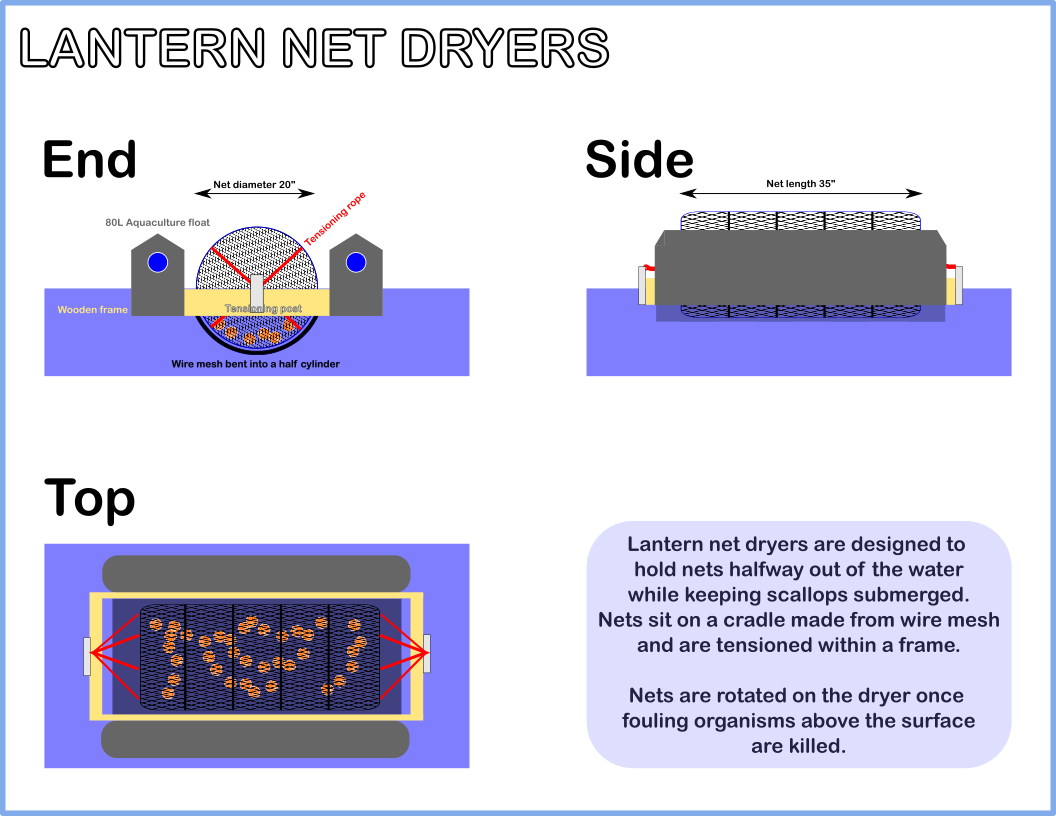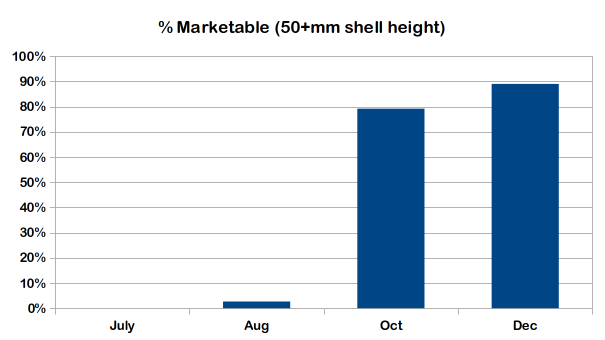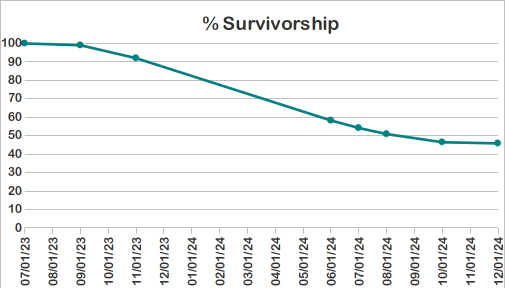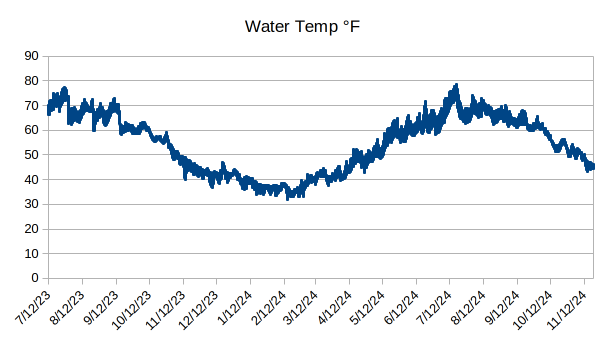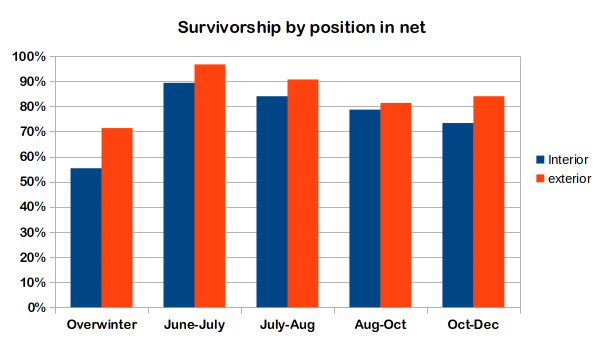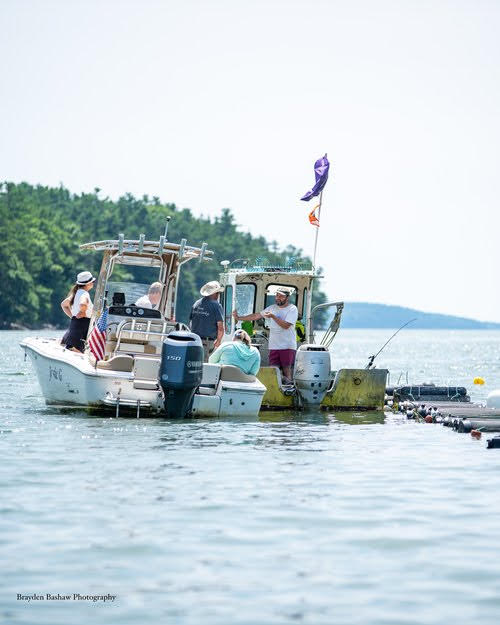Final report for FNE23-052
Project Information
This project sought to test whether bay scallops (Argopecten irradians) could be grown as a secondary species on a Maine oyster farm.
Scallop seed was grown in lantern nets (first in spat bags, then loose) from July 2023 until December 2024. Staring at month ten, scallops were stocked at 75 individuals per lantern net tier. Lantern nets were dried on a specially designed raft to prevent and removing fouling, while reducing the amount scallops were handled.
The majority of scallops (79%) reached a marketable size by the 15th month of growth. Mortality (driven by unusually severe fouling by mussels) was high, particularly during the overwinter off-season. Only 46% of scallops remained at the end of the experiment. These scallops were very positively received by buyers, fetched a high price, but required a large amount of labor to process.
Outreach was conducted at two conferences that focused on farmers and scientists, on a public-facing farm demonstration day, and directly to an agricultural co-op. Social media outreach was focused mainly on other sea farmers.
1) This project aimed to test whether bay scallops could be grown in rapidly-warming Maine waters. Our approach used techniques that were developed to grow bay scallops in their traditional range and techniques used to grow sea scallops locally. Success was gauged by growth rates and survivorship from planting in July 2023 until harvest in December 2024
2) This work aimed to address biofouling and handling issues associated with lantern nets (the most successful grow-out gear used in other trials), by building a raft that allows scallops to stay submerged while portions of nets are air-dried. Fouling species on nets were compared to those seen elsewhere on the farm.
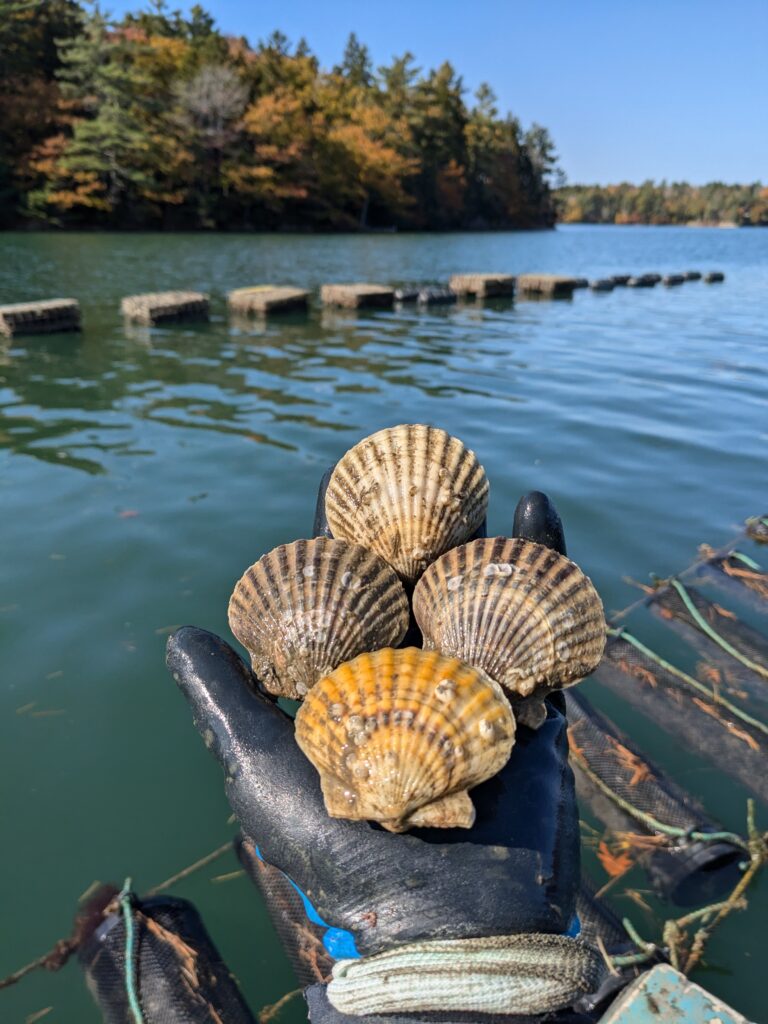
Most Maine seafarms operate as monocultures, leaving farmers vulnerable to pests, pathogens and changing environmental conditions, as well as swings in demand. By adding a crop with different environmental and spatial needs, farmers could address this vulnerability without displacing their primary crop, potentially increasing yield without expanding their footprint on the landscape.
The floating subtidal oyster farms most common in the region use just the top few feet of the water column. Lantern net culture (growing shellfish in hanging tiered nets) offers farmers an opportunity to grow shellfish in deeper waters in their existing lease footprints. This middle section of the water column is sheltered from major wave action and sees much less sedimentation than the ocean floor. This position is ideal for scallops, which are sensitive to both turbulence and smothering.
Two species of scallops are present in the northern Gulf of Maine. Sea scallops (Placopecten magellanicus) are endemic and widespread. Bay scallops (Argopecten irradians) are a more southerly species that is slowly encroaching as waters warm. In Maine, much active research focuses on sea scallop aquaculture. This project will focus on growing bay scallops in part as a climate adaptation strategy in region with some of the fastest warming waters on the planet.
Bay scallops are a commercially important species that demands a high price- particularly from the wild populations in southern New England (with Nantucket bay scallops fetching a price as much as 50% higher than local Maine sea scallops during the PI’s time working in fish markets). These wild populations are under stress from habitat loss and fishing pressure and are only available during a short harvest season (Nov. 1 through March 31 in MA, the closest wild fishery). A successful aquaculture crop could help take pressure off of this population and expand availability into other parts of the year. Bay scallops can be sold on the half-shell market, offering oyster growers a secondary product to sell to their existing networks of distributors.
Previous work saw some success in lantern net culture- with sea scallops locally, and with bay scallops in other locales. Crop loss due to biofouling and difficulty handling nets and are cited as problems in this work. Unlike oyster cages, lantern nets stay submerged. Biofouling organisms (most problematically colonial tunicates and sea vases) can rapidly smother and weigh lantern nets down, causing crop mortality and making lifting/handling difficult or dangerous for the farmer.
To deter fouling organisms, net drying rafts were built for this project. This raft was used to periodically hold lantern nets horizontally at the surface of the water with half exposed top the air, killing pests above the water line. The dryer kept sensitive scallops submerged, reducing handling stress. Nets were rotated to insure each surface is dried. Drying offered an effective strategy to clean nets without the noise or energy use of pressure washing.
I am the owner of Winnegance Oyster Farm, located on the New Meadows River in midcoast Maine. The farm is in its eleventh year of operation. I began harvesting in September of 2015 and switched from part-time to full-time work at that point.
My farm is comprised of four limited-purpose aquaculture licenses (LPAs) encompassing a 1600 sqft footprint. The farm produces up to 71,000 oysters a year. The majority of my oysters are sold to seafood wholesalers, though I have operated a farm-share and sold directly to restaurants in the past.
My background is in environmental biology, and I have also worked in horticulture and the seafood industry. I've received SARE farmer grants in past years: building tide-powered equipment to clean and tumble oysters, studying polyculture of littleneck clams and eastern oysters, using shading to prevent algal biofouling, and product differentiation of oysters on my farm.
Cooperators
- - Technical Advisor
Research
One millimeter shell-height scallop seed was acquired from a hatchery (Muscongus Bay Aquaculture) on July 13 2023. Seed was stocked in soft spat bags with a 0.5mm mesh for initial nursery phase using a stocking density of 10000/bag. Mesh was stretched into a frame using segments of garden hose and bags were sealed with zip ties
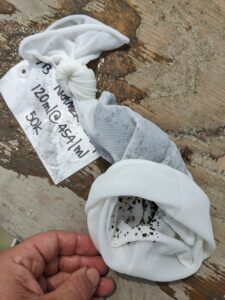
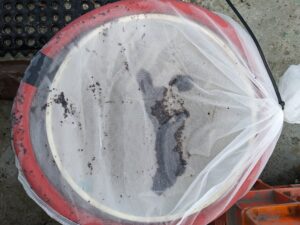
Spat bags were loaded into lantern nets (one bag per tier) and were suspended from a floating longline at Winnegance Oyster Farm in 27’ of water (mean high tide depth).
During this initial nursery phase, scallops were checked weekly determine timing of movement to a larger mesh size (0.75mm) to minimize loss to sifting and handling. Scallops were large enough to be moved into 0.75mm mesh spat bags without loss after one month of growth.
Scallops remained in .75mm spat bags until early November (when the smallest individuals were of a sufficient size for grading). Seed was graded in an onboard water bath using rigid mesh sieves and shell lengths were recorded. Seed was split between three lantern nets that stayed at the surface through the winter. Equipment was not handled from Dec to March (when the farm is not operating due to ice and dangerous winter weather), but the lantern nets were checked for storm damage before the resumption of farm operations in April.
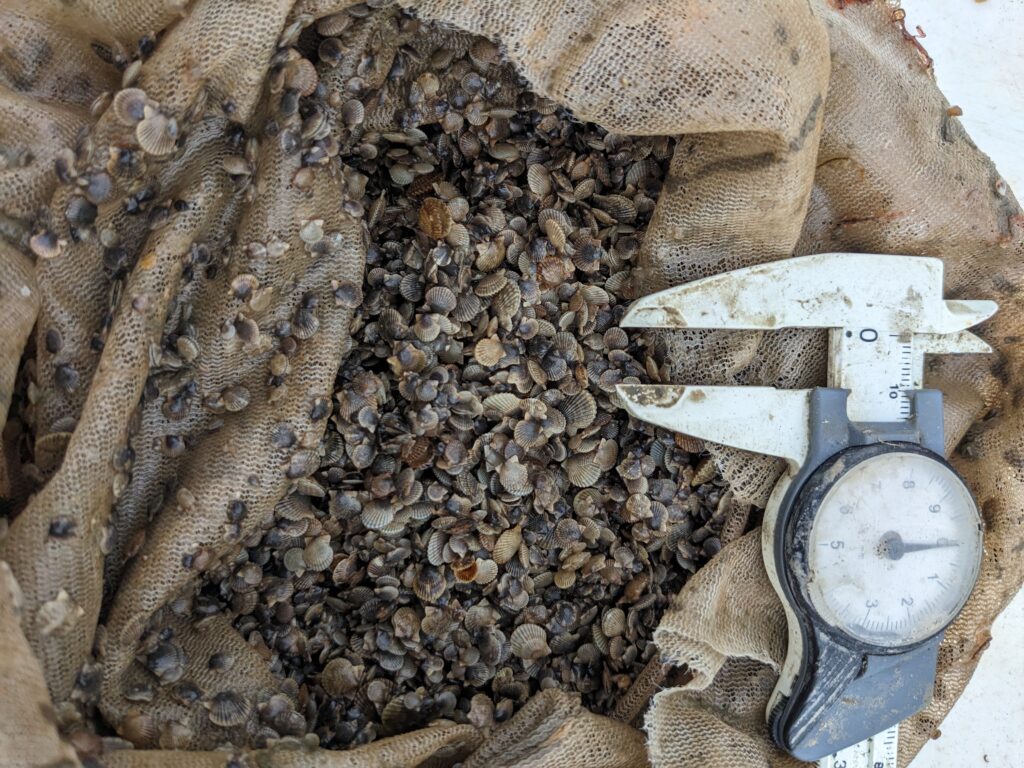
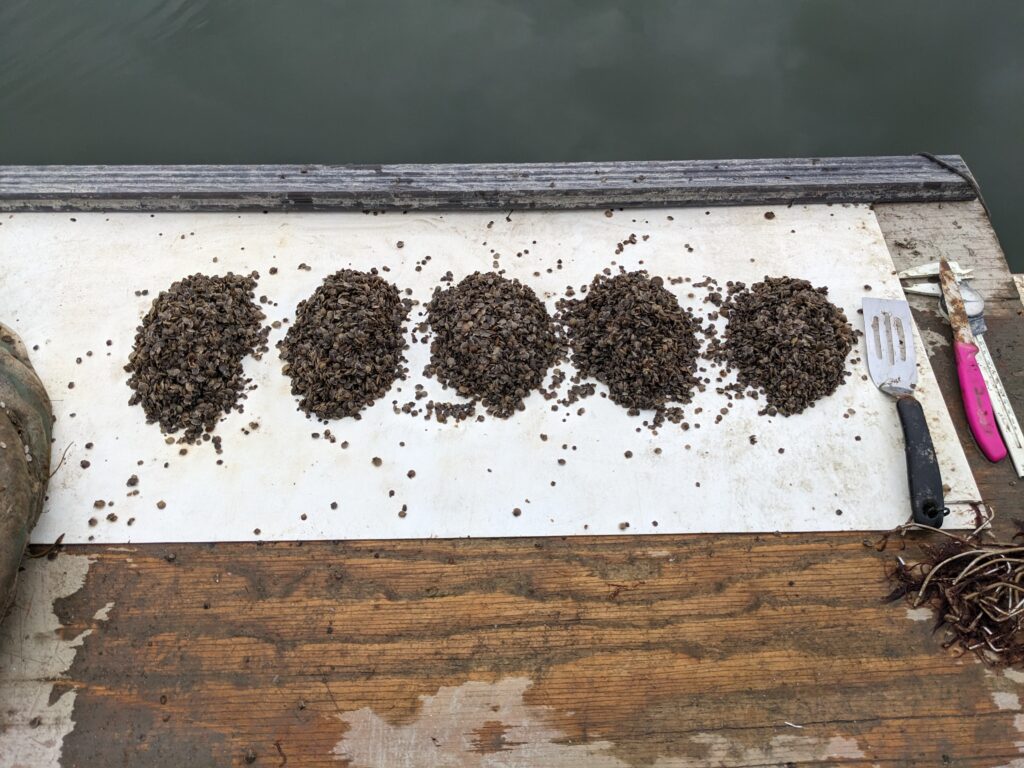
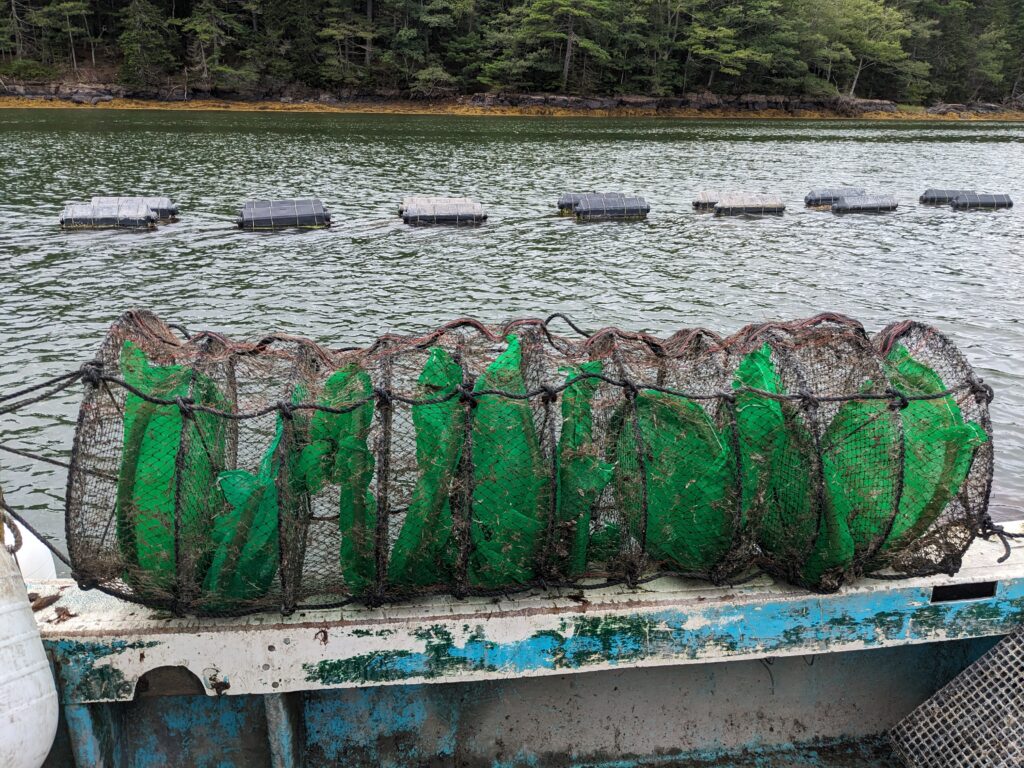
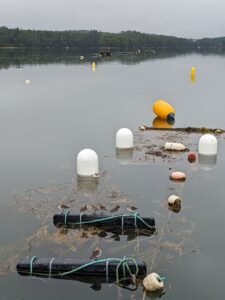
In the spring, observation of shell lengths and mortality resumed. Scallops were stocked at a density that initially covered 33% of lantern net tiers to prevent overcrowding mortality (cited in personal communications by several sea scallop growers- 75 individuals/tier in this case).
Lantern nets were dried on a purpose-built raft to prevent biofouling. The final iteration of the net drying raft consisted of a cedar lumber frame holding a wire mesh half cylinder. Two 80 liter oyster cage floats were fastened to the sides for flotation. Nets rested on the mesh half submerged- keeping scallops safely in the water while fouling organisms were exposed to the air.
Each net was dried no more than once every two weeks to ensure adequate feeding of scallops. Fouling species and prevalence were noted. Nets were dried until there was visible confirmation that fouling organisms were dead (algae and bryozoans desiccated, sea squirts discolored and empty of water). Drying times varied by season and fouling species (one to three days per net side, each net rotated in the raft once to expose the previously submerged portions).
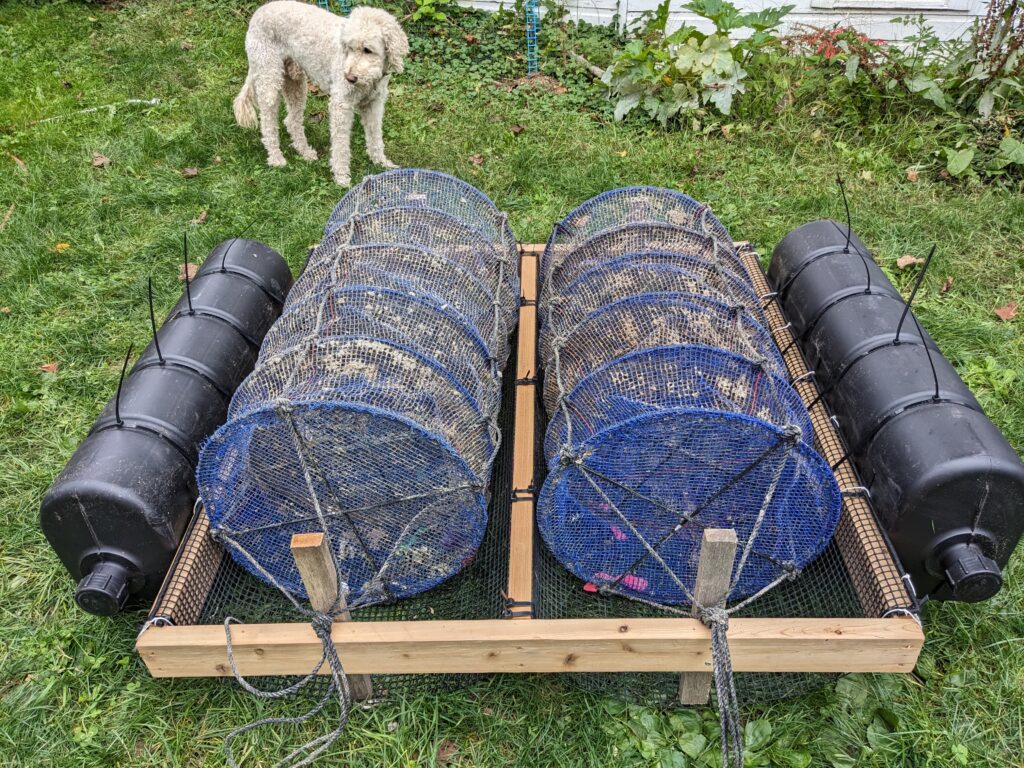
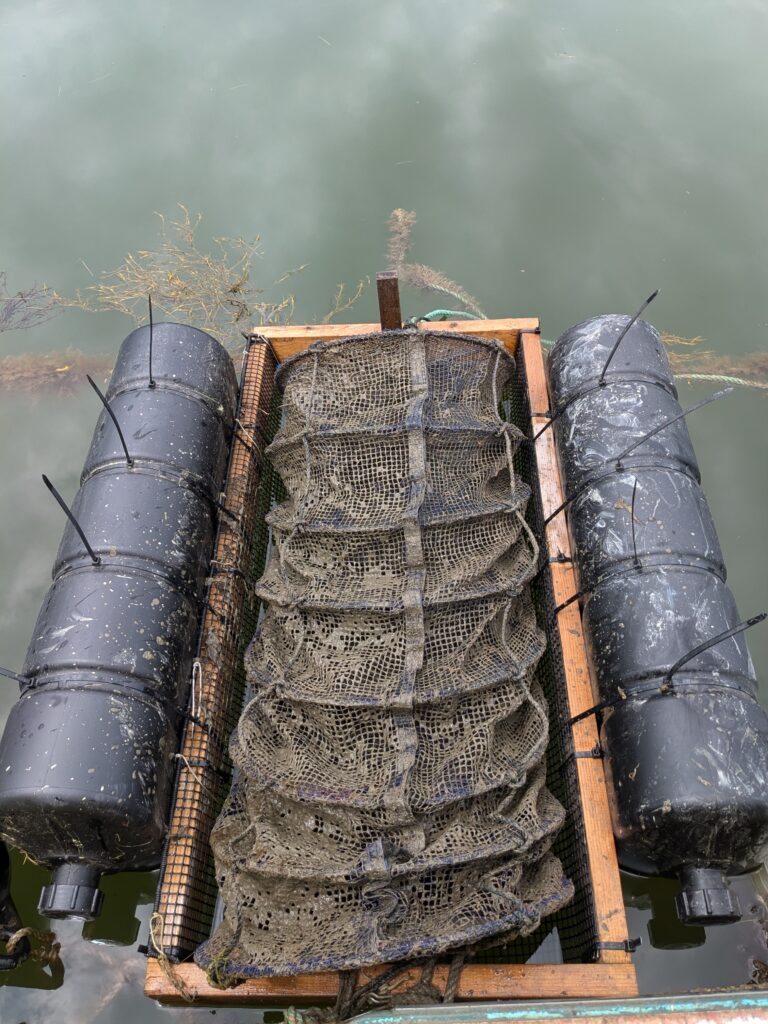
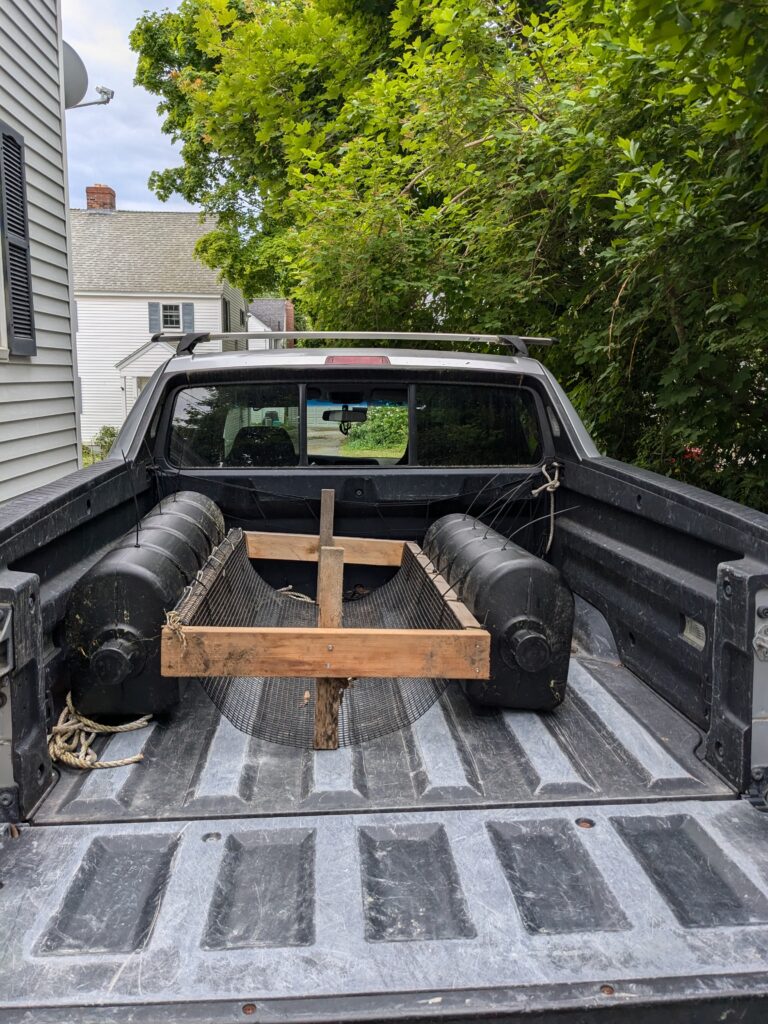
In October and December of 2024, the cumulative number of scallops reaching a minimum market size of 50mm were noted. Scallops for the trial were sold to local seafood dealers to gauge their market value.
Seawater temperatures were recorded on our existing loggers.
Growth
In the nursery phase (first four months on the farm), scallops grew between 6 and 40 times their initial length (1mm). On average scallops reached 22.3mm at end of season measurements in November 2023. Growth continued at a high rate through the 2024 season, with the majority of surviving scallops (79%) reaching a marketable size of >50mm by Oct (15 months).
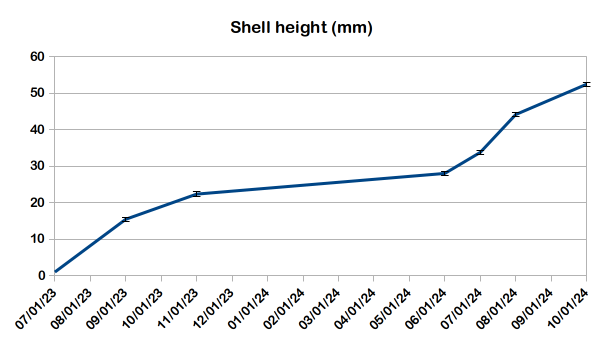
| Date | Ave. shell height (mm) |
| 07/13/23 | 1.00 |
| 09/26/23 | 15.45 |
| 11/04/23 | 22.33 |
| 06/01/24 | 28.00 |
| 07/11/24 | 33.77 |
| 08/20/24 | 44.14 |
| 10/19/24 | 52.43 |
| # Months of growth | Month | % 50mm or larger |
| 12 | July | 0.0% |
| 13 | Aug | 2.7% |
| 15 | Oct | 79.2% |
| 16 | Dec | 89.0% |
Mortality:
In 2023, mortality between stocking the farm in July until September was <1%. By Nov 4 mortality had reached 8%. Mortality was largely seen when mussel fouling was present. The byssal threads produced by mussels caused clumping in bags inhibiting feeding.
Overwintering mortality was substantial. Lantern nets were heavily fouled by two distinct cohorts of mussels, continuing the pattern seen throughout 2023. Mussel fouling contributed to a large and atypical loss of oysters on the farm over this same time period. The farm was also hit by six storm-force weather events (70mph+ wind) during off-season months. Winter temperatures were much warmer than typical- and the warmest recorded on the farm in the five years data loggers have been present. These warm temps would theoretically have a positive effect on the survivorship of this more southerly species. With unusual conditions and without a longer dataset, it is hard to draw conclusions to whether the Gulf of Maine has become more hospitable to bay scallops as it has warmed.
| Date | % Survivorship |
| 07/13/23 | 100.00 |
| 09/26/23 | 99.00 |
| 11/04/23 | 92.00 |
| 06/01/24 | 58.27 |
| 07/11/24 | 54.19 |
| 08/20/24 | 50.89 |
| 10/19/24 | 46.46 |
| 12/09/24 | 45.84 |
In a subset of nets, mortality was compared between interior and exterior tiers. In all periods measured, exterior (top and bottom) tiers saw higher survivorship than interior tiers. This is likely a function of greater water exchange in outer tiers- letting more plankton in and more waste out. Pearl nets (which do not have multiple tiers) could be worth testing- particularly in cooler month when differences in mortality were most pronounced.
Survivorship at the end of the experiment (Sept-Dec) was somewhat deflated by keeping large marketable scallops in the trial to gauge growth (instead of immediately harvesting when shells reached 50mm).
Fouling:
Fouling patterns were exceptionally unusual in 2023. The farm saw four separate waves of fouling from mussels during the operation season, each far larger and quicker onset than anything else witnessed in the farm's 10.5 years of operation. Despite this challenge, scallops fared relatively well during the nursery phase. Though both lantern nets and the exteriors of spat bags saw colonization by mussels, the interior of bags stayed comparatively clean. This was observed in both .5mm bags and .75mm bags and contributed to the decision to delay transfer out of these bags until late fall. Fouling by other species was light and was largely made up of coral-like bryozoans and skeleton shrimp.
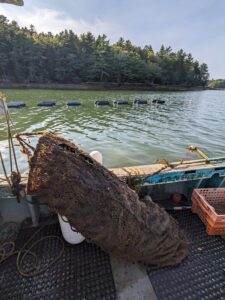
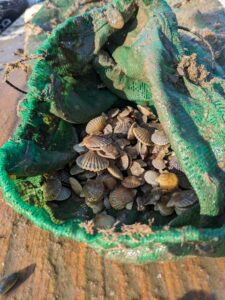
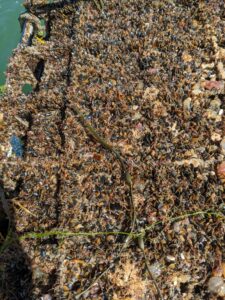
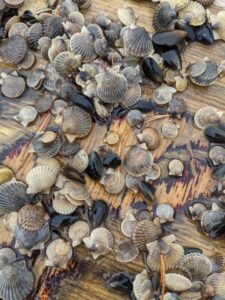
.
Heavy mussel fouling continued through the winter (when the farm is not operated)- with two distinct cohorts settling onto all equipment. Once scallops were transferred into fresh lantern nets in the spring, fouling was significantly easier to control. Drying on the custom rafts prevented most fouling from forming and what little fouling occurred between drying sessions (in the form of red algae and feathery bryozoans) was easily mitigated when nets were returned to the raft. New mussel fouling was not an issue in the 2024 growing season anywhere on the farm. Heavy fouling from several species of tunicates (sea squirts/sea vases) was noted on the farm in 2024 from Aug-Nov. The regularly dried lantern nets in the scallop trial were not affected by tunicate fouling.
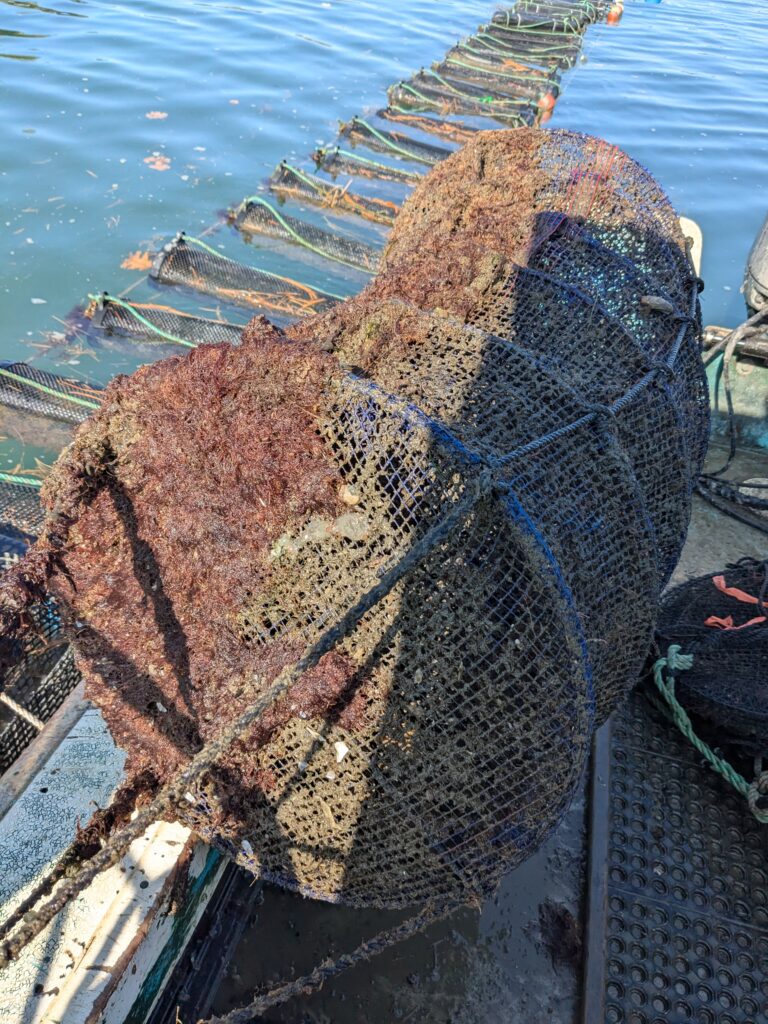
Harvest and Market
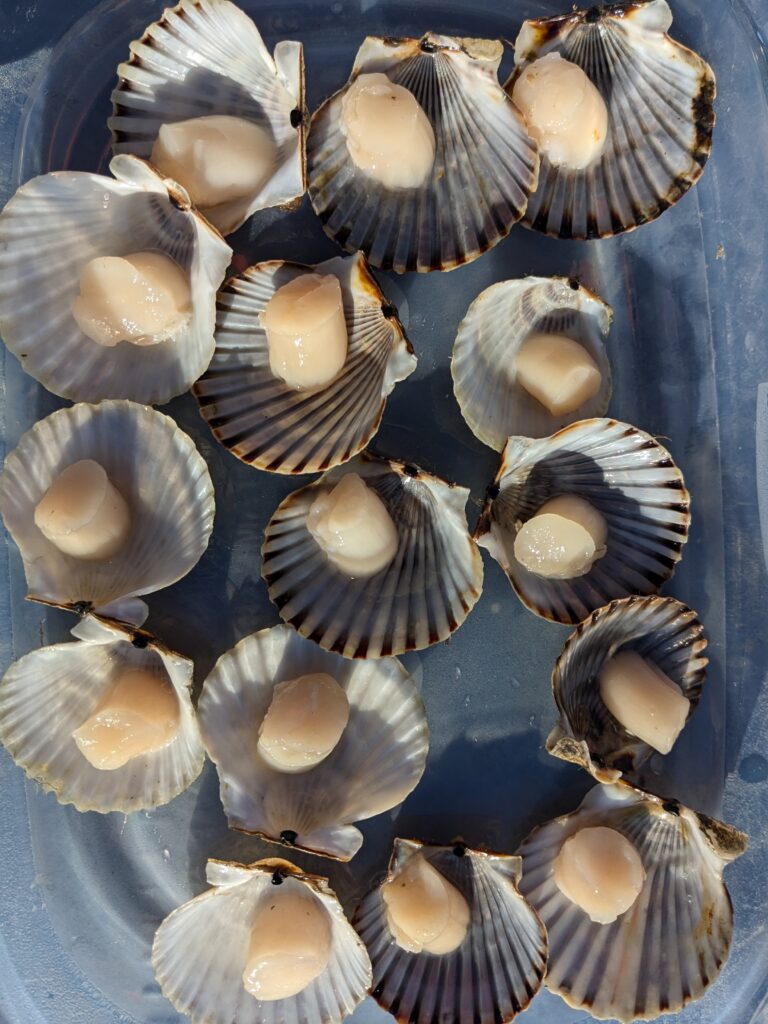
Scallops were harvested in mid-December 2024. Maine regulations currently only allow these scallops to be sold as shucked abductor meats, or abductor meats sold on shell. Shucking must occur at sea and is incredibly labor intensive. Harvest and shucking took 20hrs to produce $950 worth of product (though shucking time would be greatly reduced by a seasoned processor). This time does not include the labor of growth/husbandry.
Our shellfish-dealer buyers were instructed to pay a price they thought they could sustain- knowing this was an experimental crop. Dealers bought abductor-on-shell scallops at prices ranging from $0.75ea to $150ea, selling to retail customers for $1.50ea to $3ea. A single dealer bought meats for $45/lb, which sold to mail-order customers for $90/lb. Direct to customer sales could provide farmers with a substantially higher price, but would require additional licensing and infrastructure.
With the amount of labor it takes to grow and (especially) process these scallops, I believe they are only economically viable as an auxiliary/supplemental crop in Maine under current regulations. Conditions are much more favorable in other states, where the sale of whole live scallops is legal and/or where specialized on-land processors are present. There is currently a bill in the Maine legislature that would address this issue, (shifting the cost of enhanced red-tide testing to the state- paving the way for the sale of live scallops). If this law were to pass, the prospect of farming scallops at scale would look much more viable.
The high mortality seen in this experiment would not deter me from trying this crop again if regulatory conditions improved. The low cost of seed and timing of the bulk of the mortality (when scallops were still quite small), meant that only a small investment of farm space was needed. Interest was quite high in this product and time to market was short.
This project aimed to reduce the risks of farming a monoculture by introducing bay scallops (Argopecten irradians) to a Maine oyster farm. Bay scallops were chosen as a secondary crop species, in part as a climate adaptation strategy. The Gulf of Maine is warming at one of the fastest rates in the world. Bay scallops are more southerly species that is already making inroads in Maine waters. These scallops have a high market value and short time to maturity, making them an attractive crop for diversification.
Scallops were grown in lantern nets to utilize the vertical space of the water column. To address the high biofouling loads that make handling lantern nets difficult, a novel lantern net drying raft was developed for this project.
Scallops were planted in July of 2023 and were grown until December 2024. The vast majority (79%) had reached a marketable size of 50mm shell height by their 15th month. Mortality was high, particular through overwintering. Only 46% of scallops in the trial survived the final measurements. Mortality was driven by unusually severe biofouling by mussels during winter months when the farm was not in operation. This variable clouded our ability to test whether the warmer conditions had an effect on survivorship (relative to experiments in the 1990s). This objective could be met with a longer experiment.
The lantern net drying rafts (utilized during month of active farming- Apr.-Dec.) very effectively mitigated fouling by all species, without corresponding scallop mortality.
Growing bay scallops on my farm was clearly technically feasible- even with the high mortality seen during this project. Seed costs were low and the scallop nursery required only a small investment in farm space. Economically there are still several hurdles to making this a viable large scale crop- including the regulations that prohibit the sale of live scallops and the high labor demands of processing. If these barriers could be removed, bay scallops would be an excellent secondary crop on my farm.
Education & Outreach Activities and Participation Summary
Participation Summary:
In Nov 2023, I attended a workshop aimed at aquaculturists and researchers working in the region. I discussed the project during several roundtables, and consulted with staff from a conservation non-profit that is attempting to grow bay scallops. The workshop had ~50 attendees- most of whom were exposed to this project
In July 2024 we gave 11 tours at our open farm day. During the tours 30 people had hands on experience of gear and techniques.
A presentation of this project's preliminary results was given at the Maine Aquaculture Research, Development & Education Summit. 35 people were in attendance. The audience was polled and 15 of these identified as growers, 15 identified as researchers, and 10 identified as managers (groups overlapped).
The project was also presented to the PI's shellfish cooperative - reaching 11 additional farmers. Social media outreach posts were viewed by 2409 unique accounts.
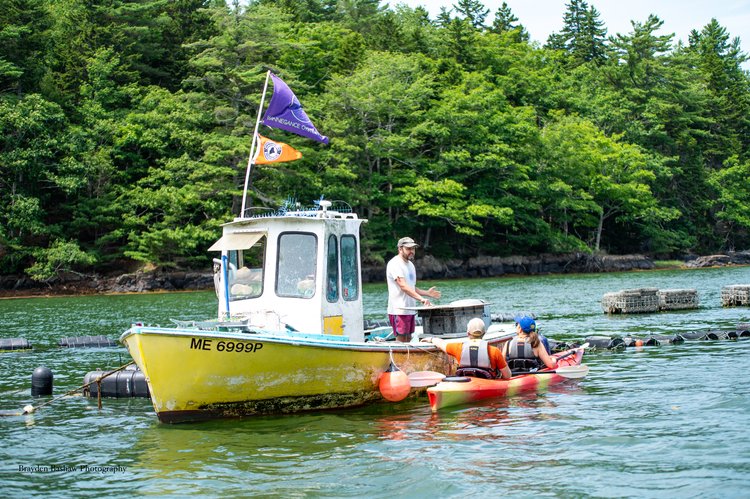
Learning Outcomes
Forty-eight farmers in the region have seen detailed 1) production methods and 2) gear handling advances promoted by this project. 15 Farmers have expressed interest in trying to grow this species, and 5 others have considered using the gear-drying raft developed for this project for other purposes.
Project Outcomes
The use of a lantern net dryer was game changing. Lantern nets use farm space very efficiently by using more of the water column, but are very unwieldy and prone to fouling. The dryers developed for this project prevented nets from becoming too heavy to handle, and did so without any corresponding mortality in scallops. Lighter nets reduced strain on my body and reduced labor. I am likely to deploy more of these nets on my farm in the coming years- effectively increasing the size of my farm vertically while in the same footprint. This additional space could help me increase my yields.
The project aimed to test whether scallops could be grown in Maine's warming waters.
Fouling conditions in the 2023 growing season and the winter of 23-24 were deeply unusual and caused substantial mortality across the farm- including our primary crop (oysters). This variable made it impossible to draw conclusions about whether local conditions in the Gulf of Maine have warmed enough to prevent large scale overwintering mortality in the experimental bay scallops. A longer study and additional test sites could also help untangle this question.
I intend to test bay scallops again- given their fast growth rates and the enthusiastic response by my buyers. I will continue to use the lantern net dryer developed for this project.
I feel this project would benefit other farmer attempting to grow scallops in their northward-expanding range. Any farmer that uses lantern nets (for any species) could benefit from trying the lantern net dryer.
